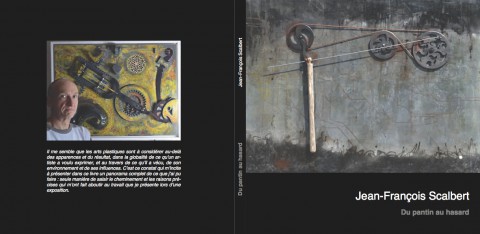The book “Du pantin au hasard”
(From jumping-jack to chance)
Text by P.A. Beuchat, 2000
(translated from the French original)
JF Scalbert, born in 1953, currently lives in the Jura in Switzerland, having spent his early childhood in France. He comes from a family of musicians dominated by the emblematic, one might say problematic, figure of a psychoanalyst father. His early years in Switzerland were marked by the disappearance of his older sister; he was left with a deep anxiety towards the immobility that death imposes and from then on his focus turned to all kinds of activity and invention involving movement. From his profession as a decorator, which he practiced from 1972, he retained an understanding for the aspect of the scenic, the window being a space where one involuntarily exhibits oneself to passers by. Thus, his first creations, baptised “pantinophones” (“jumping-jackophones”) took the form of characters animated by a hand crank and presented in a variety of windows. His first exhibition, in 1977, was encouraging. Over time and with experience, mechanisms were refined, became more complex and the jumping-jacks gave way to small animated musical artworks. Executed mainly in gouache, his first naive subjects gradually evolved into a more surrealistic style. Forty of these small paintings were created and met with great public acclaim. In 1985, both as a challenge and for fun, he designed the “Billotons,” a vertical pinball-like machine with a particularly complex mechanism. The death of his father in 1984 and then his mother a year later marked the beginning of a new artistic period: he turned seriously to painting (watercolours, acrylics and oils) in increasingly dream-like compositions. Bodies of women and musical instruments are combined in an analogy of either sensual or threatening forms. In 1987, this life of his that he had dreamt of started to become burdensome and suffocating; the struggle to find galleries that would accept and display his work contributed to his demotivation: this was represented in his artwork as aggressive graphic designs, pictures animated with discordant sounds and disturbing movements bore witness to the weariness and existential angst of the artist. Over 8 years, he operated his own graphic design studio, Créa4, which enabled him to take a step back from his creations, while exploring new techniques. In 1994, he created and led a children’s theatre troupe and a year later trained as a teacher. Once again prolific and still as eclectic both for fun and through passion, but less modest , JF Scalbert decided to once again show his work that had never really been interrupted.
Newspaper article about the exhibition FARB 2013
Let me state from the outset that to describe the journey, the research and then the evolution to Scalbert’s kinetic artwork of today, in short his entire career, would require many more lines than the short presentation that follows, but I ask you to take this as an invitation, better still a real insistence that you absolutely, I mean imperatively, visit his exhibition at the FARB in Delemont, open until November 17.In art, there is a real obligation to innovate in order not to sink into anonymity or even total oblivion; however, too often innovation leads to ugliness, not to say complete nonsense. As I once said in a poor pun, we speak of Fine Arts. Not of ugly arts.
With Jean-François Scalbert, we are “somewhere else.” The term genius does not seem enough because the ingenuity of the artist is without limit. Engineering genius is essentially evident because, as the name suggests, kinetic art involves movement.
To better understand Scalbert’s approach, let’s go back to an excerpt from the preface I wrote to his brilliant auto-biography “Du pantin au hazard” (“From jumping-jack to chance”), which has just come off the press. (…) His early years were marked by the disappearance of his older sister; he was left with a deep anxiety towards the immobility that death imposes and from then on his focus turned to all kinds of activity and invention involving movement. (…) This almost entirely explains the art of Scalbert today.
Here, there is no figurative or abstract dominance, just a fascinating play of wheels, gears, wires, pulleys, and springs, but all well hidden at the back of the work, resulting in an incredible beauty, an infinite poem. And then there is sound. Without being musical boxes, the pantinophones (“jumping-jackophones”) or the girophones of his beginnings, the artworks that are now exhibited mostly emit sounds (sometimes deliberately discordant), certainly borrowed from music but also and especially from nature and its sounds, from life and its symbols. Look at « Je vouloir aimer vous », (“I to want you to love”) or “On en revient” (“It returns”) and in another register « Serjoint » where mobile fragments combine, but for just a single moment, a rather familiar face, before breaking apart again. Or the amazing rice field in which a spiral of grooves widen by themselves as if by magic, by magic.
The artist said in a recent television programme, “I make machines that are useless.” Wrong, Mr. Scalbert: your machines trigger in the spectator an indescribable but oh so perceptible emotion.
If the above seems somewhat obscure, one single piece of advice: visit the exhibition – open until 17 November but only on Thursday, Friday, Saturday and Sunday afternoons. Questions will vanish, giving way to an extraordinary poetry, which sings like a hymn to life.
PA Beuchat, nov.2013

